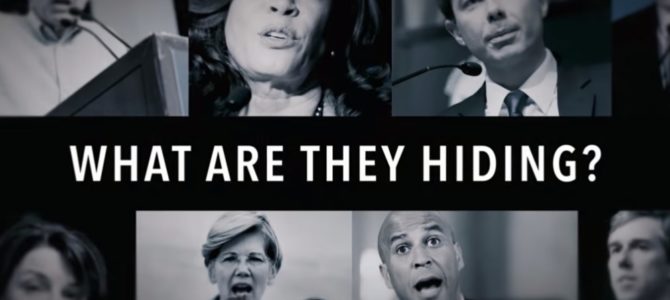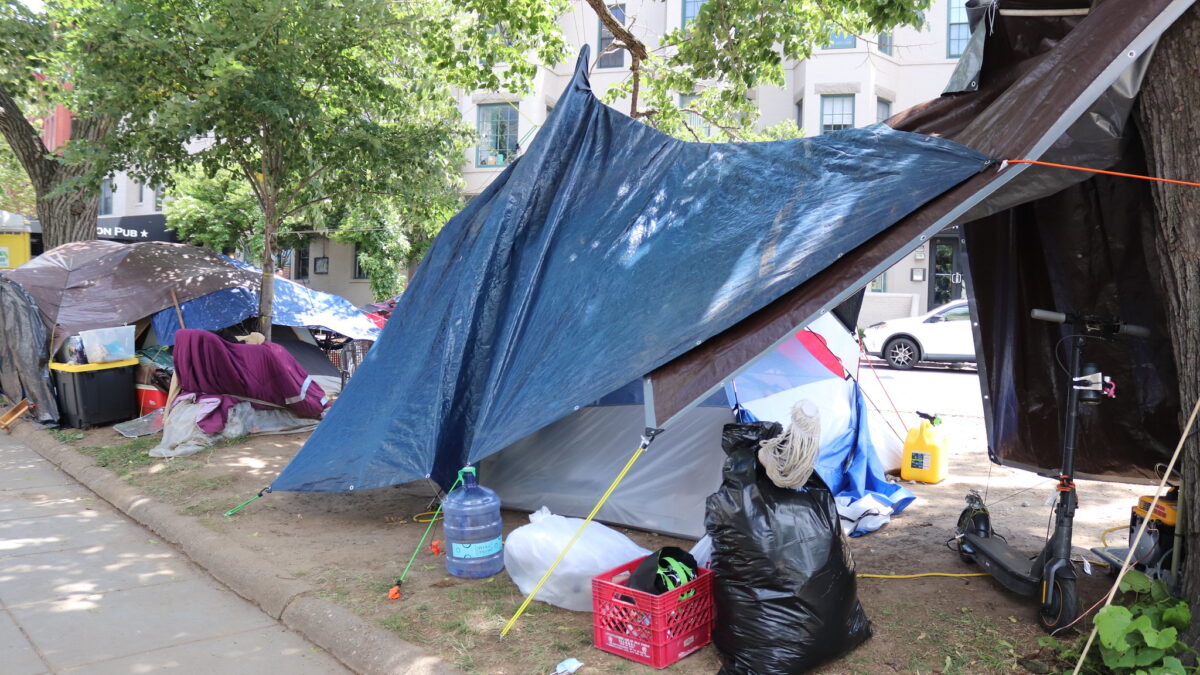
As the dust settles after the two-night Democratic debates, the political world continues to analyze what the 20 candidates said. Meanwhile, in a new major ad campaign, one conservative advocacy group aims to expose what the Democratic candidates didn’t say and why it matters.
Airing on national news networks, including NBC during the debate telecast, the $1.1 million ad buy from Judicial Crisis Network (JCN) emphasizes the importance of candidates’ potential Supreme Court picks to voters. Their new ad references New York Times reporting that liberal activist group Alliance for Justice has launched an initiative called #BuildingTheBench to advise Democratic candidates.
“Their goal is to come up with a list of judges that the next Democratic president could then have ready to appoint to the court,” said Carrie Severino, chief counsel for JCN, in a phone interview. “Yet this list is being kept secret. They fail to see that transparency was key to Trump’s success on the Supreme Court.” Further reporting has revealed that of the 20-plus candidates, only Washington State Gov. Jay Inslee has committed to releasing a list of potential Supreme Court nominees.
Attorney Phillip Jauregui, founder of Judicial Action Group, which advocates for constitutional originalism, explains why the courts have become so imperative in elections. “The truth is, the role of a judge is simply to decide a case according to the law,” said Jauregui via phone. “For five decades, we’ve seen judicial nominees who want to remake the law according to their own political worldview. Our ability as citizens to impact the laws we live under has been dictated by the Supreme Court. As the last election showed us, the American people consider the courts a big issue.”
Two of Trump’s Biggest Wins Are His Supreme Court Picks
President Trump has seen two of his nominees confirmed to the Supreme Court: Neil Gorsuch in April 2017 and Brett Kavanaugh in October 2018. Since he was inaugurated, the U.S. Senate has confirmed an additional 121 federal judges to various lower courts.
“This issue ignites the conservative base because the courts have been a promise kept,” said Severino, a former law clerk to Justice Clarence Thomas. “He nominated two judges from his list. They have been on the high court with solid originalist and textualist decisions time and again.”
In May 2016, candidate Trump announced a list of 11 potential court nominees based on guidance from scholars at The Federalist Society and The Heritage Foundation. The list was updated in September 2016 and again in November 2017 to arrive at his current list of 24 potential court nominees. “Americans were impressed with the people on that list—their qualifications, judicial philosophy, and the principles they stood by,” said Severino.
After Trump’s surprise victory on November 9, 2016, pundits pored over exit polling to account for what they got wrong. Many realized their electoral prediction models missed what motivated certain voters.
NBC News reported: “Seven in 10 voters nationwide say Supreme Court appointments were either the most important factor or an important factor in their decision to support a candidate.” Describing those motivated by the appointment of new judges, ABC News stated that these voters overwhelmingly favored Trump.
In recent decades, Supreme Court nominees have also been a source of disappointment on the right. “The list addressed what some call the ‘John Roberts problem,’” she said. “Conservatives have been burned so many times by nominees to the Supreme Court who turn out not to have an originalist judicial philosophy, or not to have the courage to stand by it when they get pushback in the media in particular.”
Severino referenced Chief Justice Roberts’ 5-4 majority opinion that upheld the Affordable Care Act in 2012, as well as the decision on Kisor v. Wilkie released last Wednesday.
The Court Picks Who Shall Not Be Named
The Alliance for Justice has coalesced various liberal nonprofits, unions, and advocacy groups to compile its list of undisclosed picks for the court.
“In some ways, imitation is the sincerest form of flattery,” said Severino. “The courts are exactly what every presidential nominee should campaign on. As the one to choose who is nominated, which the Senate confirms, the president has an outsized role. Supreme Court Justices serve for life and hand down decisions on every aspect of American life.”
With her husband serving in the Trump administration’s Department of Health and Human Services, Severino contrasts the influence of court nominees with popular campaign planks. “Executive orders can be undone immediately by the next president,” she said. “And a president has more authority on the courts than on legislation, where it all originates in Congress.”
Alabama attorney Jauregui, whose group provides detailed research on federal judicial nominations, regularly travels between their offices in Birmingham and Washington, D.C. He agrees that open discussion of the high court leads to more informed voters.
“I’m in favor of every presidential candidate—Republican, Democrat, whomever—talking about the names of people they would consider for the Supreme Court,” he said. “The American people want to know what kind of judges a candidate will nominate. When we learn the names, we can research their records.”
Led by progressive attorney Nan Aron, the Alliance for Justice famously coordinated a campaign against Judge Robert Bork in 1987 that derailed his confirmation to the Supreme Court. A lack of transparency characterized the crusade—a recurring theme, according to Severino.
“Democrats are running from this issue,” said. “If they thought these court picks were actually the kind of people Americans wanted to see on the court, they would publish the list. It’s likely so extreme, it would hurt Democratic candidates electorally to acknowledge it.”
Weighty Issues On the Scales of Justice
As liberal activists seek to emulate the 2016 court strategy with Democratic candidates, Jauregui does not foresee success. “Voters understand the importance of the judiciary, and it impacted who they put in the White House,” he said. “These candidates don’t want the American people to know the names, because then we’ll see the same types of activist judges that Democrats have always stood up.”
The controversial issue of abortion rights looms large over the discussion of any prospective nominations Supreme Court. This spring, nine states passed significant pro-life laws—notably including Alabama, Missouri, and Louisiana, the latter led by a Democratic governor. The laws have been challenged in court.
During the first night of Democratic debates, the Supreme Court came up only in the context of abortion rights. “In our country today, a person’s right to choose is under assault in places like Missouri, Alabama, and Georgia,” said candidate Julian Castro. “I would appoint judges to the federal bench that understand the precedent of Roe v. Wade and will respect it.” Legal scholars on the right including David French concur that several of the state laws are “aimed directly” at overturning Roe v. Wade.
“The left knows Roe is going to be reversed at some point,” said Jauregui. “Whether it’s as a result of one of the state laws passed recently, we’ll have to wait and see. Both liberal and conservative state legislatures are starting to make their own policies on the abortion issue because everyone sees what’s coming.”
The Coming Judicial Storm
Capping off a month of decisions, the current Supreme Court term concluded last week without the public protests of recent years. Yet wall-to-wall media coverage will surely commence with any vacancy on the high court.
“I have heard rumors of at least five of the different Supreme Court Justices retiring,” said Severino. “That’s pretty typical for this time of year—everyone’s talking about it.”
In February, Justice Ruth Bader Ginsburg, age 86, returned to the Supreme Court bench following lung cancer surgery two months prior. Speculation has also surrounded her fellow justices Stephen Breyer, age 80, and Clarence Thomas, age 71.
“We’re preparing as if we’re going to have a vacancy before 2020,” said Jauregui of Judicial Action Group. “Thankfully, President Trump has put up a list with some great names on it; some are better than others. We’ve got to get a great justice the next time we have a spot. It truly will change not just the Supreme Court for a generation—it will change this nation.”
In an interview last Monday, The Hill asked President Trump if he would make a nomination to the Supreme Court in the event of a vacancy. “Would I do that? Of course,” he answered.
Regardless of when a vacancy occurs, the Supreme Court and its effect on every American will remain substantial debate topics throughout the 2020 election cycle. “Nobody actually knows what we’ll see,” concludes Severino. “If not within the next two years, then within the term of whoever the next president is, there absolutely will be a vacancy.”









